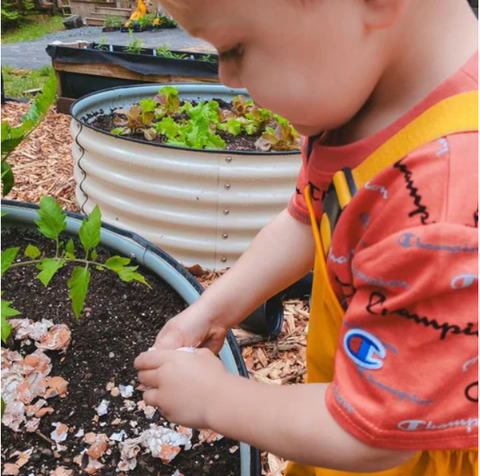Tips from Olle Garden beds:
As more people look for environmentally responsible ways to raise their own food, the centuries-old sustainable gardening method known as hugelkultur has grown in popularity. This technique blends raised bed gardening with organic materials to produce nutrient-rich, self-sustaining garden beds. In this article, we'll delve into the hugelkultur idea, examine its advantages, and offer helpful advice for establishing your own organic garden utilizing this cutting-edge method.
Understanding Hugelkultur:
Hugelkultur, which translates to "hill culture" in German, involves the creation of raised garden beds filled with a mixture of organic materials such as logs, branches, leaves, and compost. These materials decompose over time, providing a consistent source of nutrients for plants and improving soil structure.
Benefits of Hugelkultur:
1.Improved Soil Fertility: As organic matter decomposes, it releases nutrients into the soil, enriching it naturally. Hugelkultur beds can remain fertile for several years without the need for synthetic fertilizers.
2.Water Retention: The organic materials in hugelkultur beds act like a sponge, retaining moisture and reducing the need for frequent watering.
3.Enhanced Aeration: The decomposition process creates air pockets in the soil, improving root oxygenation and promoting healthy plant growth.
4.Weed Suppression: The raised beds and dense organic layers discourage weed growth, reducing the need for weeding.
5.Sustainability: Hugelkultur is a sustainable gardening method that recycles waste materials and reduces the environmental impact of conventional gardening practices.
Building Your Hugelkultur Bed:
1.Choosing the Location: Select a sunny or partially sunny location for your hugelkultur bed.
2.Gathering Materials: Collect logs, branches, leaves, straw, and compost. Consider using woody debris from your own property or local sources to minimize environmental impact.
3.Layering: Start with logs or large branches as the base layer, followed by smaller branches, leaves, straw, and finally, a layer of quality compost.
4.Shaping and Planting: Shape the bed to your desired dimensions, mound shape, or terrace form. Plant a variety of vegetables, herbs, and flowers directly into the hugelkultur bed.

Maintenance and Care:
1.Watering: Hugelkultur beds require less frequent watering due to their moisture-retentive properties. Water deeply when needed, especially during dry spells.
2.Mulching: Apply a layer of mulch to conserve moisture, suppress weeds, and regulate soil temperature.
3.Adding Compost: Periodically add compost to replenish nutrients as the organic materials break down over time.
4.Crop Rotation: Practice crop rotation to maintain soil health and prevent disease buildup.
Success Stories and Tips:
1.Learn from experienced hugelkultur gardeners who have successfully implemented this method in various climates and regions.
2.Experiment with different plant combinations and observe which crops thrive in your hugelkultur beds.
3.Keep a garden journal to track the progress of your hugelkultur garden and make adjustments as needed.
Plant Selection for Hugelkultur Beds:
- Hugelkultur beds are versatile and can support a wide range of plants. Consider growing vegetables, herbs, fruits, and even flowers in your raised beds.
- Perennial plants, such as fruit trees and berry bushes, thrive in hugelkultur beds due to the consistent nutrient supply and improved soil structure.
Extended Growing Seasons:
- The organic materials in hugelkultur beds help regulate soil temperature, allowing for extended growing seasons. This can be particularly beneficial in colder climates, where frost can limit the growing season.
- Hugelkultur beds can also protect plants from temperature extremes, providing a more stable and comfortable environment for root development.
Biodiversity and Ecosystem Benefits:
- Hugelkultur beds can promote biodiversity by creating microenvironments that support a variety of beneficial insects, earthworms, and soil organisms.
2.The decomposition process in hugelkultur beds contributes to a healthy soil food web, enhancing overall ecosystem health in your garden.
Building Community and Sharing Resources:
- Hugelkultur gardening can be a collaborative effort within a community. Consider organizing workshops or sharing resources with neighbors to build hugelkultur beds collectively.
- Sharing excess produce from your hugelkultur garden with friends and neighbors can foster a sense of community and strengthen local food networks.

Sustainability and Resource Conservation:
- Hugelkultur aligns with principles of sustainability by utilizing natural materials that would otherwise go to waste.
- This gardening method reduces the need for synthetic fertilizers and chemical pesticides, contributing to a healthier environment.
Educational Opportunities:
- Hugelkultur gardening offers excellent educational opportunities for schools, community gardens, and gardening clubs. It can serve as a hands-on lesson in sustainability, biology, and ecology.
- Involve children in the process of building and maintaining hugelkultur beds to instill a lifelong appreciation for eco-friendly gardening practices.
Monitoring and Adaptation:
- A. Regularly monitor the progress of your hugelkultur beds. Observe how the organic materials are decomposing and how different plants are responding.
- Adapt your gardening techniques based on your observations. You may need to adjust watering, amend with additional compost, or experiment with new plant varieties.
Hugelkultur gardening is a dynamic and sustainable approach that continues to evolve and adapt to the needs of gardeners and the environment. Its benefits extend beyond the garden, offering opportunities for community building, education, and resource conservation. By embracing hugelkultur, you not only create a thriving garden but also contribute to a more resilient and sustainable future. So, roll up your sleeves, build your hugelkultur garden beds, and embark on a gardening journey that combines tradition, innovation, and a deep respect for the natural world.
